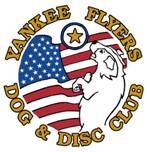
Yankee Flyers
|
Yankee Flyers
|
|
YANKEE FLYERS DOG & DISC CLUB 2003 DEMONSTRATIONS Todd J. Bachl, Demonstration Coordinatortbachl@ebmail.gdeb.compennstatertj@aol.com860-446-8110Below is the latest and greatest tabulation of demonstrations. Also check out the following pages for helpful demo hints and guidelines. Please contact me or the “Other Contact” for more information about a demonstration if you are interested.
Demonstration Helpful Hints and Guidelines
Demonstrations promote our great sport of canine disc and also the Yankee Flyers Dog and Disc Club. Anyone with a dog, a disc, and an audience can perform a demonstration. You do not need an hour’s worth of music or a flashy routine to show people what our sport is about and what our dogs can do. Anyone can volunteer for a demonstration, and guaranteed you will get more out of it in terms of experience, showmanship, and self-worth than what you put into it.
Here are some helpful “Do’s” and “Don’ts” when preparing for a demonstration –
DO’S: 1. Groom your dog(s). Your dog(s) will be the audience’s main focal point. Brush, trim, and bathe your dog(s) prior to the demonstration! 2. Make copies of your dog’s vaccination certificates and have them handy. Some venues will require proof of vaccination to enter the venue. 3. Tailor your demonstration to suit your audience. If you are performing at the Navigators for example, preparing a short two or three-sentence biography about yourself and your dog is sufficient. If you are performing at a local parks/recreation function, you will most likely need some cheat sheets with club information, etc. as well as a variety of discs to show which ones to use and which ones not to use, etc. 4. Set some groundrules for your audience if you feel the need to. Sometimes an errant throw will sail into the crowd, and inform the audience to just clear out of the way of the disc, and to leave it alone if it falls near them. Inform them to stay out of the boundaries that you set. 5. If your dog is not all that social around small children, a mesh crate is a good thing to bring along with you. Metal crates and Vari-kennels allow little hands and fingers in, whereas mesh crates do not. You may want to inform your audience to not approach your dog if this is the case. 6. Practice, practice, practice! My high school band director once told me – “Practice does not make perfect. Perfect practice makes perfect.” Perfection is an idealistic state, but with lots of practice your show will be much more professional and fluent. Feel free to contact me, Ed, or Gail to get help fine-tuning your demo. 7. Prepare and cue your music ahead of time. Most everyone has a boombox, which is usually sufficient for smaller demonstrations. Larger demonstrations usually have sound systems, and I have yet to come across an event that is unwilling to use their sound system for the frisbee demonstration. 8. Be punctual. There is nothing worse than being late for a demo. Your dog will sense your tension and hurriedness, and they may not perform at their best. Make sure you have directions and maps. 9. Prior to your demonstration, take 30 or so minutes to set up your demonstration area. Take a walk around the demonstration area and look for nails, glass, other sharp objects, holes in the ground – anything that could injure your dog during the demonstration. Pick up some orange cones at Walmart or Target to mark off your demonstration area, and take a few minutes to arrange the sound system/boombox so that your audience can hear it. 10. Have some tips for beginners handy. I usually start a demonstration by showing the audience how to get a dog started with rollers and short throws. Tell them what worked for you and your dogs, and tell them what doesn’t work (ie – don’t teach them to catch by throwing the disc at them, etc.). 11. Talk about the differences between minidistance and freestyle competitions – 1 disc vs. 5 discs, judging, scoring points, etc. 12. For freestyle demonstrators, get a volunteer to start and stop your music for you. This is one less headache you need when you’re trying to get your dog, discs, and yourself ready and out on the field. 13. Be fun, be animated, be energetic, be yourself, and let the audience be impressed!
DON’TS: 1. Don’t panic if your dog is just not working with you on the day of the demonstration. We all have our “off” days – too hot, too drizzly, too muggy, too whatever! Just do what you can with them and make the best of it, not the worst of it. 2. Don’t be afraid to go back and do one of your freestyle moves over again if you don’t hit it the first time through. You can always start your music up again to finish your routine, and finish out the music with some minidistance throws. 3. Don’t forget – veterinary records, crate, vault vest, water, leashes, music, boombox, extension cord, directions, maps, umbrella, pooper-scooper bags, snacks, drinks, cooler, etc. Make a list if you must, but make sure you have all of the essentials for your demonstration. |